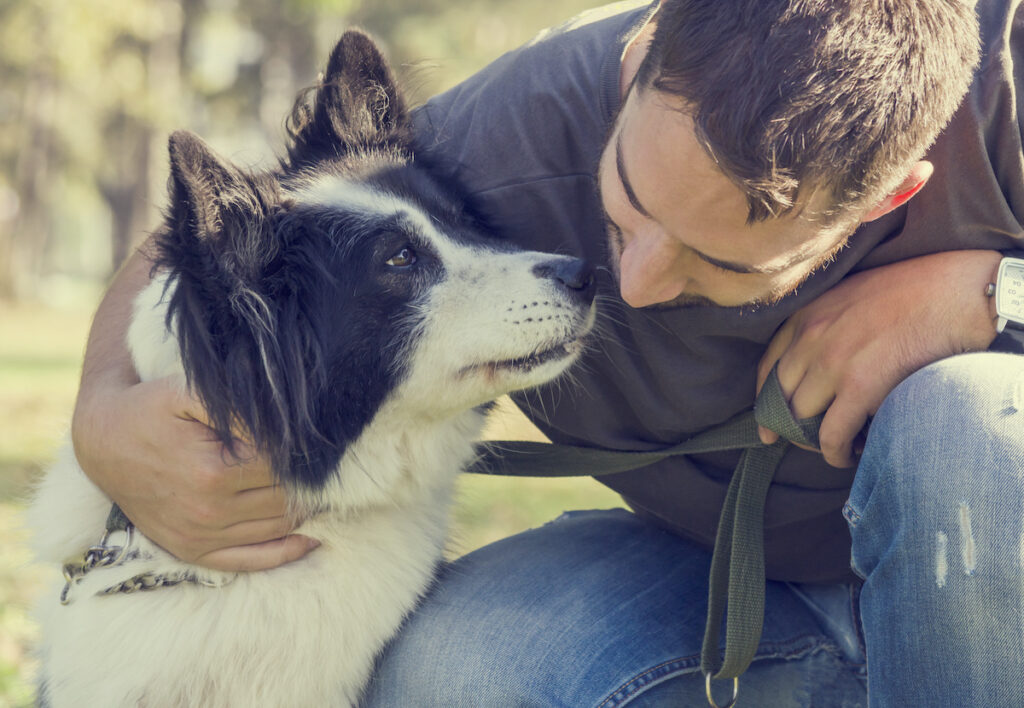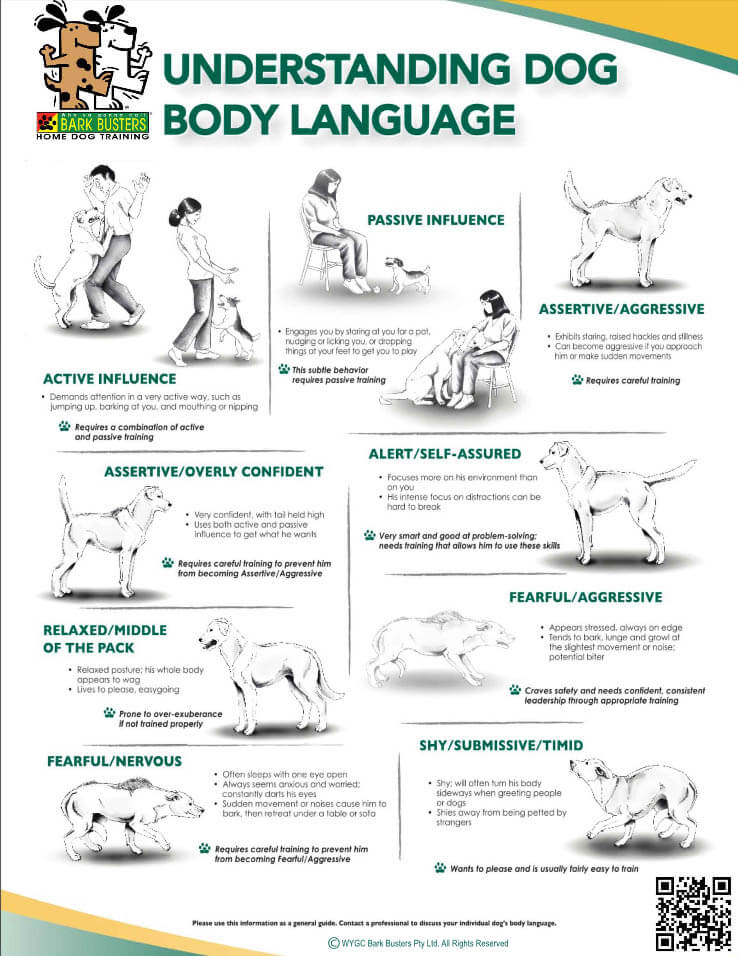All dogs, whether you raise them from a puppy or middle-age, need confident leadership throughout their lifespan. If a dog—particularly a rescue dog that may be living in a home for the first time in its life—does not sense a leader among its humans, then the dog will try to assert itself in the leader role.
When a dog asserts itself as leader in a houseful of humans, it usually leads to a lot of unwanted (and otherwise avoidable) problems. There is a solution: You have to learn how to be a confident, consistent, and compassionate leader for your new canine family member.

Understand What a Dog Wants and Needs
As the owner of a dog, you must understand your dog’s nature, as inherited from its wolf bloodline. Dogs live in a social hierarchy: There’s a leader and there’s a pack. Each pack member has a role. Dogs learn the roles by observing each other’s body language, listening to vocalizations, and picking up on scent, among other things in canine communication.
In living with humans, dogs have learned to adapt their instinctual communication style. They use scent, observation of body language, and listening to your tone of voice to determine what role you hold and wha it means for their wellbeing.
In other words, your dog is studying you to figure out if you are a threat (“will human hurt me”) or a source for the resources it needs (food, water, shelter, companionship – “human controls food”).

Understand How Your Dog Sees and Understands You
Dogs are keen observers of human behavior and it “speaks” volumes to them:
- Your body language (and your scent!) must tell the dog that you are a confident leader of its new pack.
- When interacting with your dog, your body language needs to be consistent so your dog knows it can rely on you in different situations.
- Your vocal commands and body language must be caring and compassionate so your dog knows she can trust you.

Understand Human-Canine Patterns of Interaction
In the first several weeks with your new dog, you and every member of your family need to understand common patterns of interaction between dogs and humans. It is these interactions that help the dog feel safe. It is very important to practice these patterns regularly.
When a dog knows that it can expect each family member to treat it as well as any other family member, the dog can relax. This is a crucial point because, as you may have observed already, dogs tend to interact differently with different members of the family—particularly different with children than with adults.
For example, younger children will cry, throw tantrums, and play in ways that are different from the older family members. Younger children also are less likely to be able to interpret the dog’s body language—language that may indicate “leave me alone” or “don’t do that.” You may also see that dogs play differently with children. It’s important to establish to the dog that children are members of the family “pack” but the kids not are not the dog’s puppies or siblings. If you have children, you may want to read more about this topic).
Getting back to the basics of family interactions with the new dog: When interacting with a new dog in your home, from day one you want everyone in the home to be in the habit of these types of interactions:
- approaching the dog slowly and gently
- not leaning over the dog or touching sensitive areas (tail, head)
- approaching on the dog’s level from the front, not the side or from behind
- not taunting the dog
- avoid backing a dog into a corner, which will evoke a fear response in the dog
- letting sleeping dogs lie: startling a sleeping/resting dog could be seen as a threat by the dog
- not getting angry for mistakes the dog makes—-he or she needs time to learn, you need to teach

You will want to study your dog’s body language as much as he or she is studying you.
Example:
If the dog is backing away from you, he wants space and you need to give that to him. He should have a crate, mat, or other safe space to himself. Is the dog’s body relaxed or tense? Is his tail up or down? These and many other subtle and obvious shifts in the dog’s body can give you clues to what she is experiencing and needs from you.
When it doubt, speak to Dr. Otto Williams, DVM at the Animal Care Center of Smyrna to help you understand what your dog is saying to you. Dr. Williams offers a free initial consultation for new patients.
The Importance of Consistency in Routine
If you don’t have a daily routine for the dog, you need to create one.
Dogs are creatures of habit. They look to you to know when it is okay to engage in a certain way. The initial few weeks a new dog is in your home is a time for that all important consistency in routine. Otherwise, you are doing to find a lot of dog droppings around the house, demands for playtimes when you don’t have the time, and perhaps a chewed-up carpet will be the result of the dog’s frustration and confusion.
Over time, many dogs more easily adapt to changes in your schedule. This is because of the trust that has been established through previous leadership, compassion, and consistency in caring for them. They may need a few days, even a week, to get settled in, but they’ll be able to do so without much stress.
Confident Leadership as a Dog Owner
Confident leadership means not showing confusion or uncertainty when the dog makes a mistake in the home, barks incessantly, or shows other problematic behaviors. Most behaviors considered problematic by owners happen for a reason. It is the dog’s way of communicating with you. A confident leader tries to figure out what the behavior means and correct for it so it does not happen again. They do this without screaming at, scaring, or punishing the dog–that is, they respond with with compassion.

How do you become a confident and compassionate leader for your dog?
You can begin with these simple steps:
- Read books about training your dog (see Resources below) or
- Take an obedience class with your dog.
- Learn about the breed.
- Each day have a 15 minute reward-based training session with your dog.
- Make sure every family uses the same verbal commands and hand signals. The dog won’t understand what to do if one person uses “come” and another persons uses “here.”
- Give your dog LESS freedom in the home, and have him earn more house privileges as time goes by. Additionally, if you don’t every want a dog on the furniture, don’t let her on some times, but not others; or on one chair but not another chair. The dog cannot discern these differences.
- Use tether training with your dog. Wherever you go around the house, the dog follows (except for the rooms you don’t want the dog going into). You can learn more about tether training here.
- Don’t repeat yourself. Having to repeat yourself just teaches the dog not to listen. The dog gets one chance: If you give a command and she doesn’t obey, follow through with what you expected.
Example: If you give the “sit” command and the dog does not sit, gently move the dog into position. Reward your dog with a treat and loving ear rub when she is in position. - Reward the dog for the right behaviors. Always reward your dog for the behavior you want from her, especially in the beginning of training. It’s really easy to inadvertently reinforce a behavior you don’t want from your dog.
Example: The dog runs to the door when the bell rings. He is whining to see who is there. You give the dog verbal or physical attention at this time (“It’s okay Fido, it’s just the delivery man. It’s okay.”) You’ve just reinforced running to the door and whining. You can learn to discern the subtle difference between reinforcing and the right behaviors and eliminating undesirable dog behaviors by taking an obedience class or reading a book on dog training. Both are worth the investment. Ask your vet to suggest training classes in the Smyrna area.
Training Your Dog Builds a Lifelong Bond
There is so much to learn about your new dog and for them to learn about you. When done with compassion, consistency, and confident leadership this can lead to a beautiful, lifelong bond between you and your canine companion.
Dogs do learn and many undesirable dog behaviors can be prevented or corrected.
If you start off on the right foot—er, paw—then you will be less likely to have to correct problem behavior later on. If you do run into difficulties trying to train your dog, be sure to check-in with your vet for advice. For the most compassionate and leading-edge pet care services in Smyrna and surrounding areas, request an appointment and let Animal Care Center help you carefor all of your pet’s needs.
Resources
Maran’s Illustrated Guide to Dog Training (Book)
Training the Best Dog Ever: A 5-Week Program Using the Power of Positive Reinforcement
by Larry Kay
WholeDogJournal.com has a newsletter and magazine






